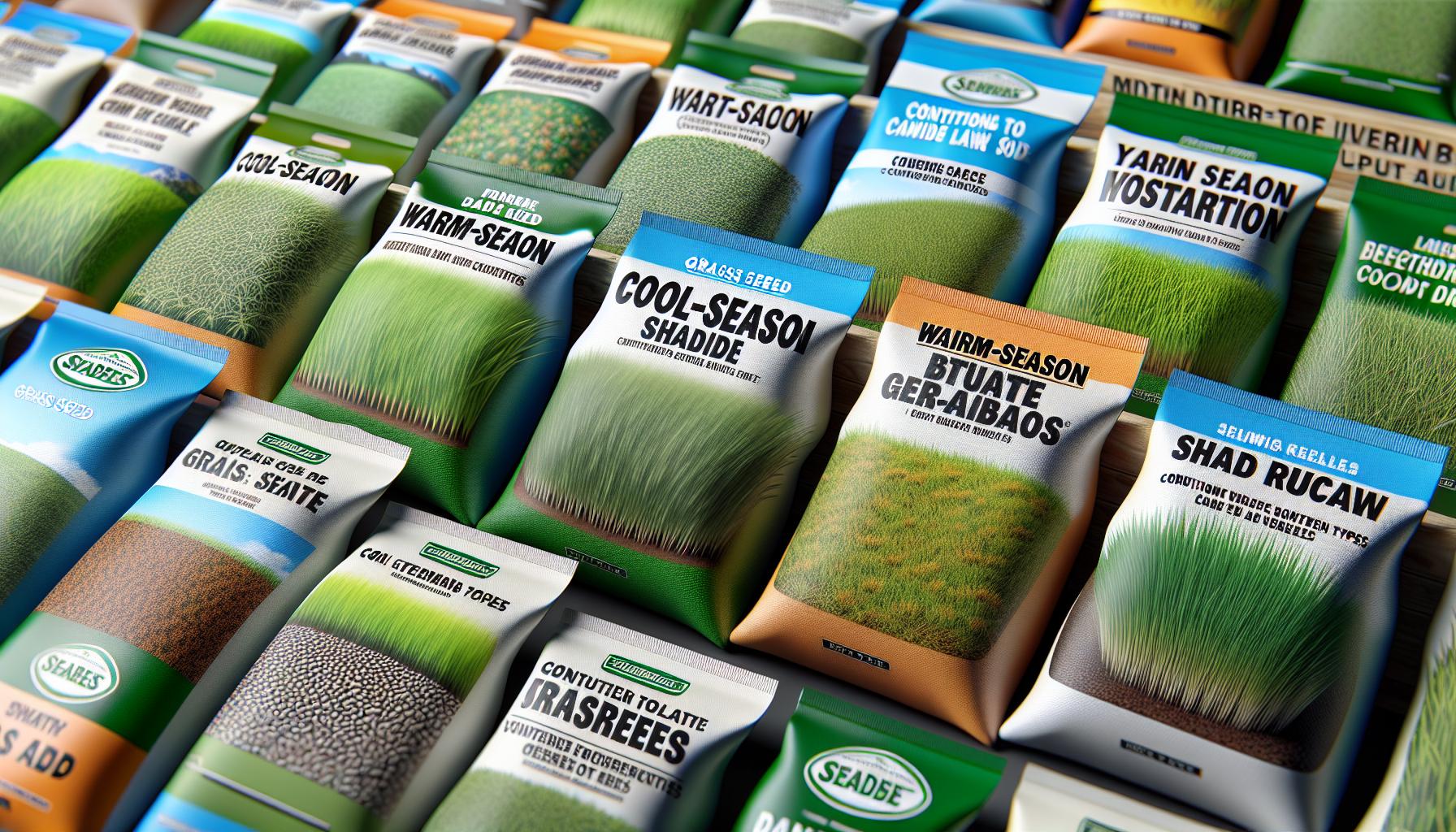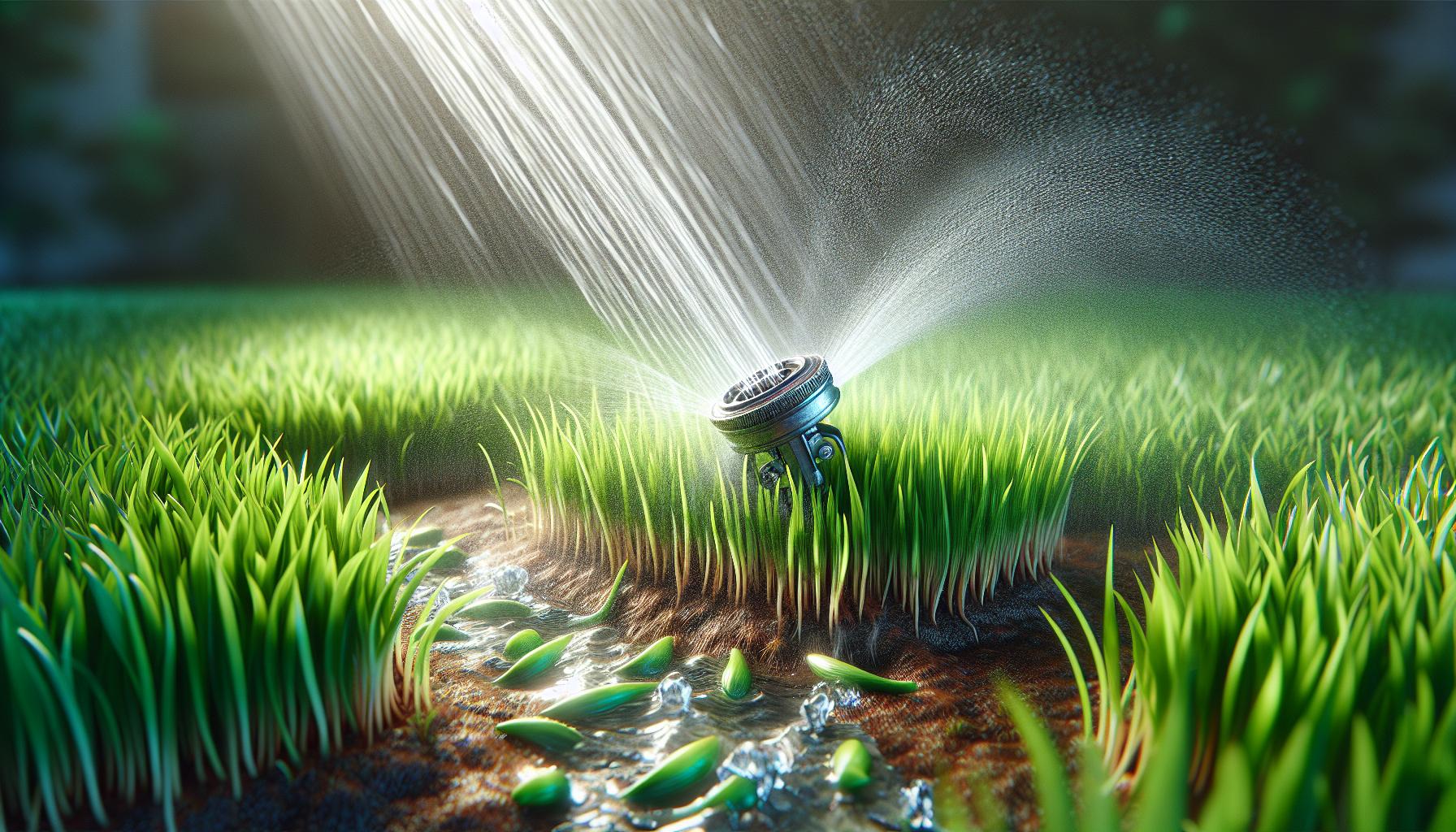
Overseeding your lawn without aerating might sound like a shortcut, but it’s a proven method that can breathe new life into your turf. If your lawn’s looking sparse or worn, this technique can fill in the gaps and boost its health without the extra labour that comes with aerating. It’s all about making the right preparations and ensuring good seed-to-soil contact.
Fall is often the perfect time to overseed, taking advantage of cooler temperatures that favour seed germination without the stress of summer’s heat. With the right approach, you can achieve a lush, vibrant lawn that’s the envy of the neighbourhood. Let’s jump into how you can overseed effectively, ensuring your lawn remains a lush, green oasis.
Benefits of Overseeding
Overseeding your lawn is an impactful way to promote a lush, healthy garden without the need for aeration. This method not only invigorates your existing turf but also introduces new life into your garden with minimal effort. Let’s investigate into the myriad of benefits that overseeding provides, focusing on improvements to lawn health and overall appearance.
Improves Lawn Health
When you overseed your lawn, you’re essentially giving it a fresh lease of life. This process increases the density of the grass, which in turn, reduces the opportunity for weeds to take root. A thicker lawn also means less space for soil erosion, ensuring that your garden remains fertile and less prone to water runoff issues.
Proper seeding leads to a robust root system, which is pivotal in maintaining the health of your lawn. A strong root system enhances the turf’s resilience against drought, disease, and pests. By selecting high-quality, disease-resistant grass varieties, you’re investing in the long-term vitality of your lawn. Overseeding, especially when done in the optimum conditions of early fall or spring, ensures your grass has the best start, resulting in a more vigorous lawn capable of withstanding various stresses throughout the year.
Enhances Lawn Appearance
Overseeding has a transformative effect on the visual appeal of your lawn. Dense, vibrant turf is the hallmark of a well-maintained garden, and overseeding is key to achieving this. By filling in bare patches and thickening thin areas, overseeding promotes uniform growth, which significantly enhances the overall uniformity and texture of your lawn.
Besides, introducing new grass varieties through overseeding can bring about improved colour and disease resistance, lending your lawn a richer, more vibrant hue. This diversity in grass types can make your lawn more adaptable to changes in weather and soil conditions, ensuring it stays green and lush throughout various seasons. The visual improvement that comes with a healthily overseeded lawn not only creates a more inviting outdoor space but can also increase the curb appeal and potentially, the overall value of your property.
In essence, the act of overseeding is a relatively simple yet effective method to rejuvenate and maintain the health and appearance of your lawn. With the right approach and timing, your lawn can become a thriving, resilient, and vibrant outdoor space that complements your home and lifestyle. By understanding and implementing the benefits of overseeding, you’re on your way to creating a beautiful, sustainable garden that requires fewer interventions and thrives year after year.
Choosing the Right Grass Seed

Considering Grass Type
When you decide to overseed your lawn without aerating, selecting the right type of grass becomes even more crucial. Understanding the specific needs of your lawn and the characteristics of different grass types ensures a successful overseeding project. Grasses can be broadly categorized into two groups: cool-season and warm-season. Your geographic location plays a pivotal role in this decision.
- Cool-season grasses thrive in northern climates and include varieties like fescue, bluegrass, and ryegrass. These grasses prefer the cooler temperatures of spring and fall.
- Warm-season grasses flourish in southern climates and encompass types such as Bermuda, Zoysia, and St. Augustine. These varieties are more suited to the warmth of late spring through to early fall.
An effective strategy is to choose a grass type that matches your existing lawn to ensure uniform growth and appearance. If your lawn features cool-season grass, opting for a similar variety ensures the new grass integrates smoothly, enhancing the lawn’s overall texture and colour. On the other hand, if your lawn hosts warm-season grass, sticking to that type guarantees the overseeded areas will thrive under the same temperature conditions.
Selecting the Appropriate Seed
Picking the right seed isn’t just about the type of grass; it’s also about the quality of the seed itself. High-quality seeds have a higher germination rate, are more disease-resistant, and are better suited to your local climate conditions. Look for labels that specify “weed-free” or have a high purity percentage. These aspects indicate that the seeds are free from weeds and other impurities, ensuring you’re only planting what you intend to grow.
Consider the following when selecting your seed:
- Shade tolerance: If your lawn is partially shaded, opt for a seed mix designed to thrive in both sun and shade. This ensures even growth patterns across different areas of your lawn.
- Wear and tear: Some grass types offer higher durability under foot traffic. If your lawn is a bustling hub of activity, choosing a hard-wearing grass type is vital for maintaining its condition.
- Water needs: Water conservation is increasingly becoming a priority for many gardeners. Opt for drought-resistant varieties if your area experiences water scarcity or if you wish to reduce water usage.
By choosing the appropriate seed mix, considering factors such as climate, existing lawn type, shade coverage, and water availability, you’re laying the groundwork for a lush, resilient lawn. Remember, the success of your overseeding effort hinges not just on the overseeding process itself but on the informed choices you make before sowing a single seed.
Preparation Before Overseeding

Before you begin on the journey of overseeding your lawn without the step of aerating, preparation is key. Proper groundwork ensures that the new seeds have the best conditions to germinate, grow, and integrate seamlessly with your existing lawn. Here’s how to prep:
Mowing the Lawn
Mowing your lawn is the first crucial step in the preparation process. You should cut your grass shorter than usual, but be mindful not to scalp the lawn. This act reduces competition for sunlight, water, and nutrients while making it easier for the new seeds to reach the soil. Ideally, you should aim to mow your lawn to about 2 inches in height. This height is optimal for exposing the soil slightly, which assists in better seed-to-soil contact, a vital factor for successful seed germination.
After mowing, it’s advisable to collect and remove the grass clippings. While these can sometimes act as a natural mulch, in the context of overseeding, they may hinder the direct contact between seeds and soil.
Clearing Debris
Once the lawn is mown, clear any debris such as leaves, twigs, and stones from the area. This step is not merely cosmetic; it’s functional. Debris on the lawn can create physical barriers to seed dispersal, preventing an even spread and creating patchy areas in your lawn. Also, accumulated organic matter can harbour pests and diseases which can be detrimental to both existing and new grass. A lawn free of debris allows for a clean slate for overseeding, promoting uniform growth and reducing the risk of fungal diseases.
For thorough cleaning, use a lawn rake or a leaf blower to ensure that even the smallest obstacles are removed. This meticulous approach will make a significant difference in the efficacy of the overseeding process.
Watering the Lawn
Prepping your lawn also involves watering but with a twist. Before sowing new seeds, it’s wise to water the lawn a day or two in advance. This preliminary irrigation ensures that the soil is adequately moist, creating a conducive environment for seed germination. But, be cautious not to overwater and create muddy conditions, which can lead to seed runoff during rainy spells.
The goal is to achieve a consistently damp soil profile to a depth of about 6 inches. Utilizing a screwdriver or a similar tool can help you check the moisture depth. Proper soil moisture is a balancing act; it should not be soggy but should hold enough moisture to support the new seeds until they are well established and can be regularly watered along with the rest of your lawn.
Initiating your overseeding project with meticulously prepared soil sets the stage for a lush, dense, and healthy lawn. Paying attention to these preparation steps is what differentiates a successful overseeding task from a mediocre attempt. Take your time, follow these guidelines carefully, and your lawn will reward you with vibrant growth and resilience against environmental stresses.
Overseeding Process

When your lawn begins to show signs of wear, overseeding without aerating can become a vital maintenance strategy. This process revitalises your lawn, encouraging dense, healthy growth. Let’s jump into the steps to ensure your overseeding effort brings the lush, vibrant lawn you aim for.
Spreading the Seed
To begin, selecting the right type of grass seed that matches your current lawn is crucial. If you’re unsure, Consult Your Local Garden Centre for advice. Once you’ve got your seed, the spreading technique you employ can make or break the effectiveness of overseeding. Using a broadcast or drop spreader ensures even distribution, but if those aren’t available, mixing the seed with sand can aid in spreading by hand. Whichever method you choose, aim for a uniform coverage. Remember, Overapplication of Seed Can Lead to Crowding and poor root development, so adhere to the recommended seeding rates:
| Grass Type | Seeding Rate (per 100 sq ft) |
|---|---|
| Cool-Season Grass | 3-4 ounces |
| Warm-Season Grass | 2-3 ounces |
Raking the Soil
After spreading the seed, integrating it into your lawn is next. This step is pivotal, especially when you’re not aerating. Lightly rake over the seeded area to ensure Good Seed-to-Soil Contact. This doesn’t require Herculean effort; a gentle hand is enough to mix the seed with the top layer of soil without burying it too deep. Aim for a seed depth of about 1/8 to 1/4 inches. Proper soil contact is essential for germination, increasing the chances of your overseeding project’s success significantly.
Watering the Newly Seeded Area
Watering plays a dual role in the overseeding process. Initially, Keep the Soil Moist, not saturated, to support germination. This typically involves light watering two to three times a day, depending on your climate. As seeds begin to sprout, you can gradually Reduce the Frequency but increase the depth of water to encourage deep root growth. Observing your lawn’s response is key; if you notice puddling, you’re overdoing it.
Adhering to these steps can transform areas of your lawn from sparse and uninspiring to full and vibrant. Remember, patience is as much a part of gardening as the seeds themselves. Give your lawn the time and care it needs, and you’ll be rewarded with a lush green space that enhances your home’s appeal and your outdoor enjoyment.
Aftercare and Maintenance

After successfully overseeding your lawn without aerating, the next crucial steps involve meticulous aftercare and maintenance to ensure the new grass seeds germinate and mature into a lush, vibrant lawn. Proper aftercare not only enhances the appearance of your lawn but also contributes to its overall health and resilience against environmental stresses. Let’s investigate into the essential practices of watering, fertilising, and monitoring growth progress.
Watering Schedule
Watering your newly overseeded lawn correctly is vital for the germination of grass seeds. Initially, your primary goal is to keep the top layer of soil consistently moist without causing waterlogging. Carry out a gentle watering schedule, ideally twice a day in the morning and late afternoon. This routine should last until the first sprouts appear, which typically takes between 7 to 14 days depending on the grass type and weather conditions.
Key Tips for Effective Watering:
- Use a fine spray setting on your hose or sprinkler to prevent washing away the seeds.
- During the first week, limit watering duration to avoid deep saturation; 5 to 10 minutes per session is sufficient.
- As seeds sprout, gradually reduce the frequency but increase the duration of each watering session to encourage deep root growth.
Fertilising the Lawn
Applying the right fertiliser at the right time plays a crucial role in the establishment and growth of your overseeded lawn. Approximately 3 to 4 weeks after overseeding, it’s time to give your lawn its first feed. Choose a fertiliser that’s high in nitrogen to promote lush green growth but ensure it’s suitable for young grass.
Considerations When Fertilising:
- Opt for a slow-release fertiliser that provides a steady supply of nutrients over time.
- Read the instructions carefully to apply the correct amount; over-fertilising can cause more harm than good.
- If unsure about the best fertiliser for your lawn, seek advice from a lawn care professional or local garden centre.
Monitoring Growth Progress
Keeping a keen eye on the growth progress after overseeding is essential for spotting potential issues early and ensuring the development of a dense, healthy lawn. Regularly inspect your lawn for any signs of uneven growth patterns, pest infestation, or disease.
- Mark the date of overseeding on your calendar and track the growth milestones.
- If you notice areas where the grass isn’t catching on, consider lightly reseeding those patches.
- Be vigilant about lawn pests and diseases; early detection makes treatment more effective.
Throughout this process, patience is key. Some areas may take longer to fill in than others, and weather conditions can significantly influence the growth rate. By adhering to a consistent aftercare and maintenance routine, you’ll be well on your way to enjoying a revitalised lawn that enhances the aesthetic appeal of your home.
Conclusion
With the right approach and dedication, overseeding your lawn without aerating can yield fantastic results. Remember, the secret lies in diligent aftercare and maintenance. Ensuring your lawn is watered gently yet consistently, using nitrogen-rich fertilisers at the correct times, and keeping a watchful eye for any signs of uneven growth or pests are crucial steps. Patience is your best ally in this journey. Weather conditions and the nature of your lawn’s soil will play significant roles in how quickly you see results. By following these guidelines, you’re setting the stage for a vibrant, healthy lawn that’s sure to be the envy of your neighbourhood.
Colin Macmillan is a seasoned entrepreneur and the CEO of Riverwood Landscape, a leading landscaping company based in Canada. He has been at the helm of the company since leaving high school, demonstrating his strong leadership skills and business acumen.
Colin’s expertise lies in various aspects of landscaping, including lawn care, interlocking, sod installation, and commercial maintenance. His hands-on approach and dedication to the craft have been instrumental in building Riverwood Landscape into a reputable brand.
One of his most notable achievements is the creation of a successful landscape franchise that services multiple locations. This accomplishment underscores his strategic thinking and ability to scale operations effectively.
Colin has also had the privilege of working with Guelph Hospital for landscaping and maintenance, a testament to the trust and reliability that his company has earned over the years.
His professional mission is to offer the best services and experiences for customers, a goal that he tirelessly pursues. Colin’s commitment to excellence and customer satisfaction continues to drive the growth and success of Riverwood Landscape.








